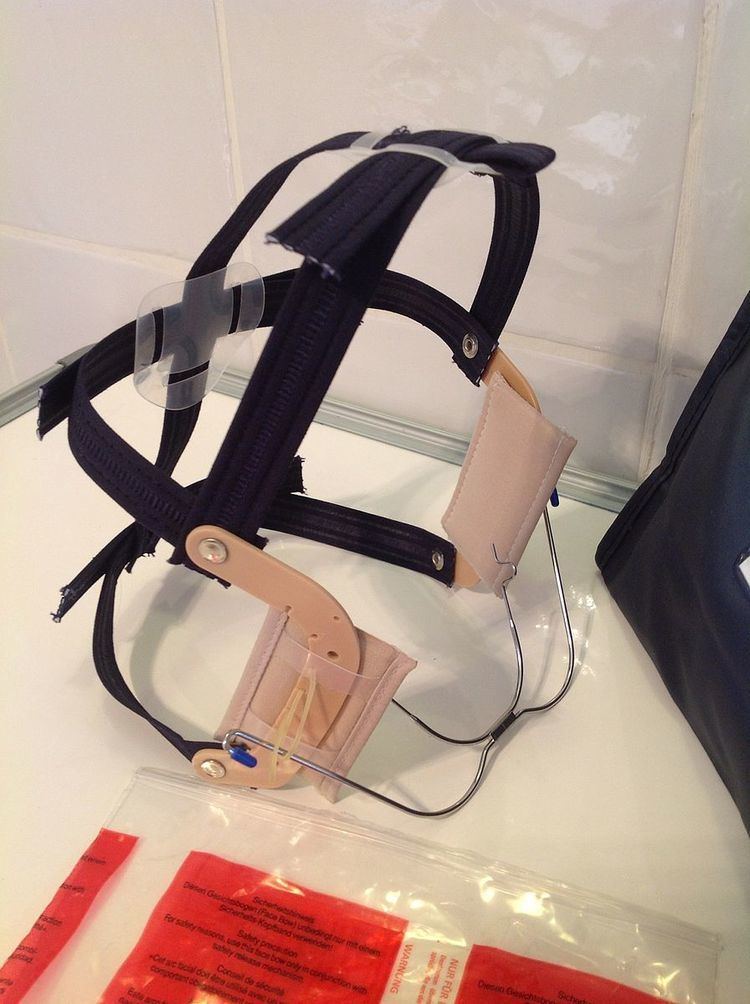 | ||
Orthodontic technology is a specialty of dental technology that is concerned with the design and fabrication of dental appliances for the treatment of malocclusions, which may be a result of tooth irregularity, disproportionate jaw relationships, or both.
Contents
- Active appliances
- Removable active appliances
- Fixed active appliances
- Functional appliances
- Orthodontic headgear
- Orthodontic facemask and reverse pull headgear
- Fixed functional appliances
- References
There are three main types of orthodontic appliances: active, passive and functional. All these types can be fixed or removable.
Active appliances
An active appliance is a device used to apply forces to the teeth to change the relationship of the teeth.
Removable active appliances
Removable active appliances are intended for simple tipping movements. Use of removable appliances in modern orthodontics is much more limited than in the past due to their various shortcomings.
Fixed active appliances
Edward Angle, regarded as the father of American orthodontics, developed many universal fixed active appliances, unifying orthodontic practice. See detailed description at Edward Angle.
Functional appliances
There is a totally different orthodontics approach without extraction and pain, is called functional orthodontics, the functional orthodontic technology is different and called functional appliance, that is an appliance that produces all or part of its effect by altering the position of the mandible/maxilla. Also known as dentofacial orthopaedic appliances, these appliances utilize the muscle action of the patient and responses of nervous system to produce orthodontic or orthopaedic forces. Various functional appliances have been described. There is a List of Orthodontic Functional Appliances.
Orthodontic headgear
Orthodontic headgear is a type of appliance attached to dental braces that aids in correcting more severe bite problems.
Headgear is an orthodontic appliance for the correction of Class II correction, typically used in growing patients to correct overbites by holding back the growth of the upper jaw, allowing the lower jaw to catch up.
The headgear can also be used to make more space for teeth to come in. The headgear is then attached to the molars (via molar headgear bands & tubes), and helps to push or draw them backwards in the mouth, opening up space for the front teeth to be moved back using braces and bands.
Headgear needs to be worn approximately 12 to 22 hours a day to be truly effective in correcting the overbite, and treatment is usually anywhere from 6 to 18 months in duration, depending on the severity of the overbite and how much a patient is growing.
Orthodontic facemask and reverse-pull headgear
Facemask or reverse-pull headgear is used to control the growth of the maxillary and mandibular bones during orthodontic treatment.
The appliance is used in growing patients to correct under bites (known as a Class III orthodontic problem) by pulling forward and assisting the growth of the upper jaw, allowing the upper jaw to catch up.
Facemasks or reverse-pull headgear needs to be worn approximately 12 to 22 hrs to be truly effective in correcting the under bite, usually anywhere from 6 to 18 months depending on the severity of the bite and how much a patient is growing.
The appliance normally consists of a frame or a centre bars that are strapped to the patients head during a fitting appointment. The frame has a section which is positioned in front of the patients mouth, which allows for the attachment of elastic or rubber bands directly into the mouth area. These elastics are then hooked onto the child's braces (brackets and bands) or appliance fitted in his or her mouth.
This creates a forward 'pulling' force to pull the upper jaw forward.
